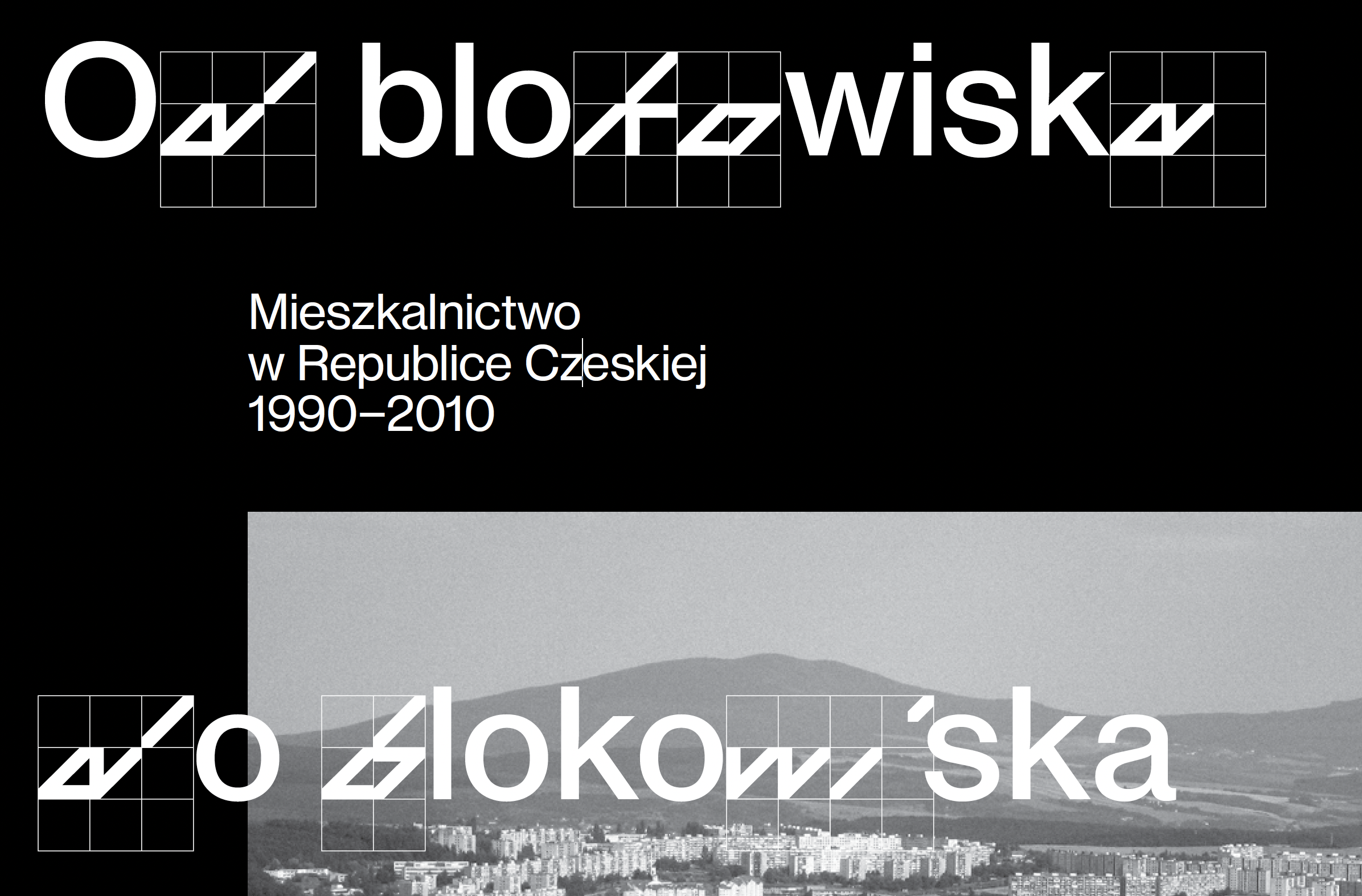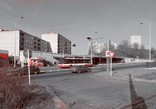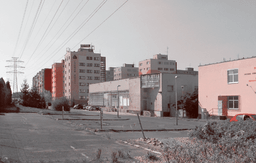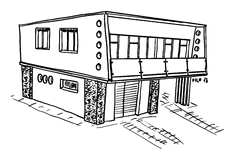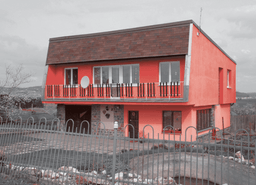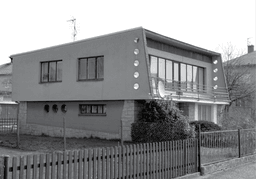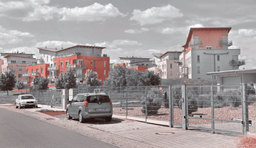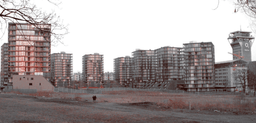Housing in the Czech Republic 1990–2010
“Foxes have dens and birds have nests, but the Son of Man has no place to lay his head.”
Luke 9:58[1]
It is difficult to write about housing in the lands of the former Czech Republic[2] without excessive use of the word “crisis”. The complex sphere of housing always consists of an intricate tangle of social issues. If we were to consider this concept in its full Heideggerian sense,[3] we would end up delving deep into the sensitive issues of home, fatherland, individual and collective identity. Here, too, we would not manage without the word “crisis”. Instead, we will start with a simple quantitative account: over the last century, the Czech Republic has not recorded a single year in which there would be sufficient housing for everyone, but in its turbulent history, the lack of housing has more than once turned into a housing crisis. Its cause has not changed since the turbulent urbanization of the nineteenth century: the number of inhabitants for whom housing is financially difficult to access is growing the fastest, whereas the number of dwellings available for them is growing the slowest.
According to the last census, by January 1, 2011, there were a total of 4.76 million flats in the Czech Republic. This means 465.5 flats per 1,000 inhabitants – slightly less than the EU average (489.4).[4] After all, statistical data can be deceptive. For example, in Spain, there are 549.7 dwellings per 1,000 inhabitants, the highest number in Europe, but this indicator is not related to the overall well-being; after the investment bubble broke, Spain also has the highest vacancy rate. In the Czech Republic, 83.4 per cent of the available housing units are occupied. In absolute terms, this means that 652,000 apartments are empty.[5] We do not know exactly what proportion of those is accounted for by landlord speculation on the rising real estate prices, but it is certainly the majority.
The average age of the inhabited dwellings is fifty years. Thus, a typical Czech apartment remembers socialism, the Soviet occupation, the fall of the communist dictatorship, and the collapse of the common state of Czechs and Slovaks. Many flats, of course, have survived both world wars – indeed, some of them go back as far as the Napoleonic wars. However, statistics are more interested in newer apartments. In 2019, 36,419 apartments were put into service throughout the Czech Republic and the construction of another 38,677 started, most of them in Prague (6,487) and Central Bohemia (6,489).[6]
Moving to the apartment block
The pace of new construction can be measured by the rhythm of housing crises. We will never settle this matter once and for all. The housing stock is physically used up; new needs and opportunities arise. It has never been possible to reduce the difference between the number of flats needed and those built. Only the width of the gap, and the means expected to solve the problems have changed.
After World War I, the young Czechoslovak Republic tried to make up for the inherited shortage of housing. At the level of municipalities and cooperatives, conditions were created conducive to the construction of new apartments, while limiting speculation at the same time. Then came the economic crisis and not all plans were realized. Immediately after World War II, the housing situation did not seem too dramatic. Compared to Poland or Germany, the losses that we suffered on the housing market because of the war were minor. What is more, as a result of post-war displacement, former German flats and houses became vacant. There were so many of them that not all were utilised during the re-populating of border areas. In the five years from 1946 to 1950, the average annual increase was only 1.39 new dwelling per 1,000 inhabitants. The focus was on repairing the economy. The recovery in housing construction began only with the advent of socialist industrialization. Apart from the state, the role of housing cooperatives has gained importance again. The culmination took place in the 1970s – when the annual average growth exceeded 8 new apartments per 1,000 inhabitants. Unfortunately, the economy could not cope with such dynamics; stagnation set in, and by the end of the 1980s the growth rate had dropped by almost half. After the collapse of the centrally planned and governed economy, the gap has widened: in the first half of the 1990s the annual average was 2.73, and in the second half of the 1990s it was only 1.99.
The post-war development, although it related to the postulates of typification, standardization and industrialization proclaimed by the interwar functionalism, degenerated into the production of an extremely limited range of prefabricated elements and construction techniques; they did not bring the desired price reductions or accelerated development. On the other hand, apartments in the projects offered an upgrade, with cold and hot water on tap, one’s own toilet,[7] central heating, elevators, plenty of fresh air and light, and above all, a relative abundance of space. The designers of the functionalist minimal apartment calculated an area of 9 square meters per one adult; between 1970 and 1980, this increased on average from 12.4 to 14.6 square meters per person, and finally the standard was adopted of a 3 + 1 apartment with a usable area of 74 square meters, and a living area of 49 square meters.
The layout of new apartments was not only a mechanical consequence of economic requirements, as is commonly believed, but above all a distant echo of the functionalist concept of housing. It was assumed that the use of flats would change to fit the idea of a new socialist lifestyle. According to the program of ideal social functioning (a flat without a household), many household activities – such as cooking, washing, or ironing – were to be provided by external, state-run service points. This has never been realized; on the contrary, in socialism there was shortage of virtually everything, and under such circumstances the role of the household, paradoxically, increased even further. Of course there was no way that the apartments could fulfil the functions that the designers did not plan for.
Moving out of the apartment block
The socialist state had no sympathy for single-family houses.
The single-family house under capitalism became a stronghold of petty bourgeoisie. After all, the owner of a single-family home feels greater class solidarity with other owners, and not only of single-family houses. In his way of thinking, the seeds of individualism germinate; and the belief that his own interests should come first is reinforced. When all this ballast gets to the broad masses of citizens of the state, it immediately inhibits the development of society.[8]
Of course, the broad masses of citizens of the state did not cease to dream about a single-family home with a garden as an ideal dwelling; furthermore, the state was aware that the so-called comprehensive housing development would not be enough to solve the problem of the housing shortage. From 1953, independent construction of one’s own single-family home was allowed; later, those willing to undertake it were additionally supported by dynamically operating cooperatives. The joint studio of Stavoprojekt and the National Standardization Institute issued templates of single-family house typical designs, textbooks for amateur builders began to appear, and several journals covered the topic. However, all this happened on the margins of architecture. In fact, the type of the single-family house known from the interwar period was simply replicated. Its roots went back to early modernism and since then it had matured into a universal form, almost devoid of any style.
These new possibilities emerged only after the period of Stalinist traditionalism, and aroused the need for a stylish single-family house that was an expression of modern life. Significantly, the need was satisfied from below, and outside the city centre: in 1967, architect Josef Vaněk presented a new model of a single-family house. He built his first houses in the Šumperk district whence they quickly spread to the villages and outskirts of smaller towns throughout the territory of what was then Czechoslovakia. The largest number of such houses is found in northern Moravia. Researchers also found one building just across the border, on the Polish side.[9] The designer named his creation ‘type V’, but soon people started talking about šumperák houses. The diminutive šumperáček was also used, clearly exuding the bliss that the lucky ones felt when their dream of a perfect dwelling came true. (Similarly, the diminutive phrase rodinný domek – a little single-family house – which in the second half of the twentieth century ousted rodinný dům – a single-family home – from the Czech language, signifies something more than the modest size of individual buildings at that time).
Why was šumperák so popular? Josef Vaněk employed all his practical experience as a bricklayer, and he perfectly understood the needs and possibilities of a builder who did not have many resources at his disposal, and had to do most of the work with his own hands. At the same time, the design bears clear formal traces of the Brussels style, so called in reference to the success of the Czechoslovak pavilion at the Expo’58 exhibition in Brussels. The sources of šumperák can be found in the Residência Prudente de Moraes Neto in Rio de Janeiro – a project by Oscar Niemeyer from the 1940s – but Vaněk freely drew on and adapted from the original. This was a translation of the 1960s modernity to a language understood by a layman, so that the builders could refer to it when working on the construction of the house and its finish.
In šumperák single-family homes, there was a clear division between the utility section and the residential section. On the ground floor of the house of slab-on-grade structure there was a garage, which also served as a home workshop, a laundry room, a boiler room with a drying room for clothes, and a fruit and vegetable storage space. A tiled, covered terrace occupied a quarter of the building’s plan. In the entrance hall, the stairs led to the upper floor with a living room, a bedroom, a kitchen-cum-dining room, a pantry, a bathroom, and a toilet. The layout of the dining room and the kitchen area, the size of the balcony and the sanitary facilities as well as built-in wardrobes clearly indicate a close relationship between the šumperák plan and the apartments in the block of flats. The house did not require a great deal of materials: simple concrete foundations, ground floor made of bricks, with a reinforced concrete ceiling slab on it, cellular concrete or brick upper storey, simple roof structure covered with galvanized steel sheet. Giving the house its character were the stone facing bricks in the ground floor, the texture of the finishing plaster, the larch wood moulding, the balcony railing – a graceful field for the creativity of the builders.
For the entire two decades, subsequent houses were built according to or based on Vaňek’s design, as imitations of šumperák or variations on his theme. It was not until the mid-1980s that the stylistic features of the model were definitely exhausted, and the construction of šumperák houses was stopped. The owners of these buildings began to modernize them, therefore in the 1990s they did not become – unlike blocks of flats – a substitute attribute of socialism; the aversion to them was rather generational. In order to understand the housing situation in the Czech lands in the 1960s, 1970s, and 1980s, it is worth juxtaposing šumperák houses, at the time the most typical realization of a longing for a room of one’s own, with apartments in a block of flats. Apartment blocks were built in many countries in Europe at that time, while the šumperák is an endemic Czechoslovakian phenomenon.
At the end of the socialist era, apartment blocks offered roughly 1.2 million flats and more than three million Czechs, Moravians, and Silesians found their home there. As late as 1995, the construction of the last housing estates was being completed, and all the while the escape therefrom was already happening. It seemed a mass exodus at the time, because it was one of the ways in which people cut themselves off from the socialist past. Blocks of flats and housing estates were top of the list of its symbols, and it was a popular, commonly quoted opinion that socialism had thrown us into concrete towers.
In the twentieth century, two fetishes of freedom were established: one’s own car and a single-family house. In the Czech lands, both were making their way slowly. In the Masaryk Republic,[10] the car was officially considered an anti-social luxury. The socialist state later treated single-family homes in a similar way. During the communist era, the car was as scarce as housing, so for many families both these symbols of freedom remained in the sphere of unfulfilled dreams. An escape from blocks of flats should therefore be understood as a pursuit of a dream of an ideal home rather than a way out of an unsuitable way of living into a more satisfactory one. Already in the 1970s and 1980s, sociological research showed that two-thirds of the residents were satisfied with their apartment in the housing estate.[11] Even today, a third of the inhabitants of the Czech Republic live in the projects, and these are definitely not only the socially weakest people – as the gloomy forecasts of ghettoisation of housing estates were trying to scare us back in the 1990s. Some of the inhabitants have indeed been kept there by their economic situation, but we must not forget that many of them grew up in the housing estates and they identify with this environment, or at least they have got accustomed to its advantages. The technical deficiencies of the tower blocks were gradually removed during the modernization; thanks to insulation, new elevators, and the replacement of windows and sanitary facilities, the apartments now meet modern standards. The interest in them is growing, as are their prices and rents get closer to mid-range.
For a long time, the determinant of a housing estate was its unfinished, incomplete condition. After the implementation of the absolute priority investment – the construction of residential buildings – as a rule, not enough money was left for social infrastructure, not to mention greenery. The projects were commissioned decades ago, so by now the trees have grown, in the meantime, public utility buildings have been added, and the network of retail and transportation grew denser. Architects and city planners became interested in the opportunities for the development of housing estates, and the threats thereto.[12] The delight of the younger generation with the architecture of the 1970s and 1980s, often uncritical, does not weaken and, of course, it does not bypass housing estates. Fortunately, the number of scientific studies on the history of architecture and town planning of housing estates is growing, therefore their interest can go deeper and become more directed.[13] The appreciation for the projects also initiated the topic of their protection. There is a glimmer of hope suggesting that the era of aversion to the monotonous uniformity of housing estates is nearing its end. The fight against that uniformity, under the banner of humanization, deployed coloured plasters on the façades; together with polystyrene panels, glazing or enclosures in the balconies, and variations on traditional roofs, they often turned the blocks of flats into pathetic caricatures.
For fugitives from housing estates to the rapidly expanding suburbs, their former place of residence had provided them with many valuable experiences; our suburbs began in the projects. Some housing estates have a population comparable to that of medium-sized cities, which however they are not. They parasitized a real city – in much the same way as suburban districts of single-family houses are doing it today. As Léon Krier put it succinctly, both forms of housing can be called suburbs without cities.[14] Planning solutions for housing estates are rarely successful, whereas an urban concept, even if it is a good one, is not always clear to an ordinary resident. Being accustomed to a certain irregularity, blurry indeterminacy of non-urban environment, just like the experience of living in an environment without memory, is compatible with the place where everything is not quite, or at best, same old. Both forms are neither a city nor a village, also in terms of social contacts: in both, anonymity reigns along with a closed nature of private life; there is no public space, thus no meeting possibilities.
One of the appellations given to suburbs as a new form of living in the early 1990s was ‘horizontal estate of tower blocks’. The term expressed the basic paradox: the escape from the egalitarian herd of the housing estate led not to the paradise of individualism but to a different kind of herd. The form of houses also contributed to this (and it continues to do so). Mass production along with the repeatability of available single-family house designs affects individual construction; marketeers quickly learned to offer saleable goods to customers whose tastes were shaped not by architecture, but at best by tinkering with the décor of an apartment in the projects, or a woodshed in communal gardens. Therefore, both groups do without architecture – indeed, in several apartment complexes the architectural creation seems rather ludicrous. The suburbs are constantly growing in the landscape like mould, and separating the cities from that landscape. More and more new land is earmarked for development around large cities. The mould also attacks older habitats that have wisely limited their growth with the aid of a zoning plan. It is enough that you buy an older house, often modest – as in the First Republic – or limited to one hundred and twenty square meters and a maximum of five rooms, according to socialist regulations; then you tear it down and build a new, much larger one on the plot thus recovered.
In the Czech Republic, 5,989,538 passenger cars were registered by the end of last year, which means that on average, there is one car per less than two inhabitants (1.78 to be exact). In the suburbs, the ratio is more like 1:1. There, life without a car is simply not possible. The car-dependency line is somewhere between a population density of thirty and forty inhabitants per hectare. The provision of public transport can be plausibly considered with a population density of fifty inhabitants per hectare. Ordinary walking distances to shops and basic services within a quarter of an hour start at a density of one hundred inhabitants per hectare. In the suburbs, there is nowhere to walk to, or even to path to walk along. The lack of public transportation infrastructure contributes to the increase in the traffic of individual vehicles, and the economic and environmental costs of this state of affairs are borne by society as a whole – not only those who built their houses in the suburbs (the average service life of passenger cars in the Czech Republic is currently 14.93 years).
The biggest problem in the suburbs stems from the basic living conditions in a single-family home: a less economical way of living does not exist, neither in terms of materials or energy. By its very nature, a detached single-family house will never be environmentally friendly. Adding to the already mentioned needs for increased transportation, infrastructure, and the impact of travel by individual means of transport on the environment, there is something that I like to call the criterion of social acceptability. Seen from this angle, the age of Czech apartments is a positive feature. Residential buildings have an increasingly shorter “useful life”, especially in the suburbs. The problem is not limited to the service life of the buildings; it is also that society stops accepting them. One generation made their dream of a perfect apartment come true by building šumperák homes on their own, and as soon as the next generation came of age, those homes became the object of contempt. Children of refugees from the projects to the suburbs are returning to the cities, and bringing elements of their lifestyle with them when they move in to the older buildings. The principle of sustainable construction means that we will not tear down tomorrow what we have built today.
What is the situation in the Czech Republic in this respect? On the one hand, the beginnings of architects’ ecological thinking can be traced back to the 1940s. Currently, many interesting environmentally conscious buildings are being built, and extensive informational and educational activities are being conducted. On the other hand, statistics show that, for example, the number of energy-efficient A-class buildings is growing at a slow pace. The only regular growth, at 6 per cent each year, is observed in the interest in wooden houses.[15] Reflection on the change of tone in Czech society has long been hampered by the anti-environmental attitudes of some of the political representatives, but fortunately there are also enormous differences between the generations in this respect, and that brings hope. Compared to the rest of Europe, we deal with an added problem of having chosen a wrong starting point in architecture. There was no focus on social ecology. As geologist and climatologist Václav Cílek has written:
In the Czech milieu (but also in Poland, Hungary and Russia), we are not correctly defining the starting point. We are asking: how can we have the largest possible usable space, and use as little energy as possible? This conveys the impression of being sensitive to the needs of the environment, and a person who thinks this way is immediately considered to be an enlightened, prudent investor. Meanwhile, in fact, we should start by trying to devise a social model or formulate a definition of individual freedom, and consider how to arrange ourselves in a small space – fairly and intelligently.[16]
A dream of one’s own home versus poverty
The Czechs willingly blame socialism for virtually all their failures, despite the fact that almost as many years have passed since its collapse as Jesus lived, and a generation has grown up that have zero experience of the past system. It is precisely in the sphere of housing that we can see – apart from various excuses and alibis – that we are actually burdened with historical experience to this day. Tenant-owned housing, a favourite form of investment, still offers no guarantees: a tenth of the population of the Czech Republic cannot afford rent, and they are struggling with the long-term problem of bailiff enforcement; in poorer regions that number goes up to 20 per cent.[17]
Today’s poverty is the leaven of tomorrow’s poverty. A survey conducted by the ‘Lumos’ platform (a gathering of non-governmental organizations, professionals, and representatives of the public dealing with the issues of social housing and human rights) revealed that 83,000 people living in 54,000 households are experiencing precarious housing situation. Out of 9,600 such families come 20,500 minors[18], who are exposed to difficult living conditions in orphanages, nursing homes, and inadequate housing; sometimes they are placed under the tentative care of relatives or friends, and are exposed to frequent relocations. The relationship between housing and school problems of children has been proven,[19] as was the inverse relationship of higher education to the risk of poverty. However, we keep putting this malady aside, we are not looking for a solution, instead, we only struggle with the consequences; in addition, we are also plagued by the lack of legislation on social housing.
Rapid changes in social relations always follow the physical law of action and reaction. In the early 1990s, the restoration of private property as the primary form of ownership led to extreme situations. In 1991, the state and the municipalities owned 213,961 residential houses, in 2011 they were down to 48,146, and within twenty years the real estate properties of the state and the municipalities decreased by 77 per cent.[20] The dizzying pace of re-privatization deprived many people of their homes, but most of all it deprived the state and the local governments of an important tool for solving social problems and in many areas it inhibited the development of municipalities.
The ratio of the number of people living in single-family houses to the number of people living in multi-family houses (on the basis of a lease or rental contract) always reflects the condition of a given society on many levels. Out of 4.76 million flats certified in the 2011 census, 2.4 million were in apartment blocks and tenement houses, and 2.2 million – in single-family houses. In 1989, single-family houses constituted 24 per cent of the housing stock, in 2019 their share increased to 52.8 per cent. Most of the apartments are owned by private individuals, and single-family houses constitute a large part in this category. The state constantly encourages citizens to buy apartments, primarily with the incentive of low property taxes and mortgage interest rate subsidies.
This does not mean that everyone who needs a mortgage loan will get one. Under what conditions is mortgage credit currently granted? Each bank, of course, has its own requirements, but I will give you a rough example. Let’s say that I want to buy an apartment for three million Czech crowns and that this property will be my warranty for the bank, of course, this is after a careful examination of my financial situation. The bank will lend me a maximum of 2.7 million Czech crowns. It is not enough to have money set aside to cover the difference of 300,000 crowns; most likely, I will also have to come up with the difference between the default price of the apartment set by the bank and the market price. I will pay various commissions to the bank, and the real estate agency will also collect theirs. Fortunately, the real estate tax – formerly at 4 per cent of the purchase price – has been abolished recently. The amount of the instalment cannot exceed 50 per cent of my monthly income, so if I dare to take out a loan in the maximum amount, and earn a monthly net income of 25,000 Czech crowns, with an interest rate of 2.5 per cent, I will pay off the mortgage a quarter of a century later.[21] The interest rate may change; you can also imagine how I will live on the remainder of my salary for these 25 years, what will happen if I lose my job, etc. For three million crowns outside the very centre of Prague, but also not in the periphery, you can buy a studio apartment of 25 square meters, with a separate kitchen, in a newly constructed building. For the same amount, you can buy a single-family house with an area of 100 square meters on a plot of 435 square meters in a small village in Central Bohemia, though without infrastructure or efficient communication.
The number of families renting their apartment is decreasing. According to the Eurostat data, in 2018 this was 21.3 per cent in the Czech Republic, i.e. proportionally roughly the same as in Spain (23.7 per cent) or Norway (18.7 per cent), but more than half less compared to Germany (48.5 per cent), Austria (44.6 per cent) or Switzerland (57.5 per cent). Is this a healthy trend?
There is still nothing being said about growing social inequality and poverty. Fortunately, the sociologist Daniel Prokop speaks about this openly and competently:
The most overlooked inequality in the Czech Republic […] is wealth inequality. In the Czech Republic, the differences in the value of real estate owned are one and a half times higher than income inequalities. Added to that, there are also differences in savings and other assets. Wealth inequality is much more dangerous than income inequality. Instead of inspiring motivation, it leads to inheritance of poverty and perpetuation of social status. Income to some extent reflects the person’s efforts, but real estate is mainly about whether and how much that person has inherited and how much their parents are able to help them pay off a loan, especially when real estate prices are rising, most young people cannot afford to buy an apartment, and there are not many of those available to rent. From the point of view of housing, the view on income is then completely different: it is still possible to earn fifteen thousand and live in your own house in a small municipality, but renting a flat in the city while on the same salary is irreconcilable.[22]
Since the beginning of the transformation, low mobility of inhabitants has clearly inhibited social change and economic development. According to the data of 2018, in order to buy an apartment with an area of 70 square meters in the Czech Republic one would need the equivalent of 11 average annual salaries (to compare, in Belgium this would be 3.7, in Germany 5, in Poland 7.5, in France 8, in Great Britain 9.8).[23] The average expenditure for the construction of one apartment in 2019 was 3.55 million crowns for a single-family house, and 2.27 million crowns for a multi-family residential building. In terms of the average cost of constructing 1 square meter of usable space, this translates to 26,572 crowns in a single-family house, and 33,321 crowns in a multi-family building.
The average cost of rent in the Czech Republic in the second quarter of 2020 was 266 crowns per square meter, but of course it varied from region to region. The capital was the most expensive – at 299 crowns per square meter – here, however, prices differed depending on the district. In Mala Strana (Lesser Town), you needed to pay 365 crowns per meter, in Královské Vinohrady, 334 crowns per meter, and in the periphery around 200 crowns per meter. The cheapest flats for rent can be found in trans-border regions – from 73 to 100 Czech crowns per square meter. Among other things, these numbers reflect vast inequalities between the regions. Increase in the rates of rent is constant, albeit irregular. In Prague, for a long time rent has been growing at 7.4 per cent year each year; of course, this is an average increase, because in 2017, for example, it jumped by 12.5 per cent.
In comparison with other European capitals, Prague ranks among the most expensive. It is cheaper to rent an apartment in Berlin, Vienna, and Budapest, among others. We are currently seeing a downward trend as the COVID-19 pandemic has paralyzed tourist traffic. Before the pandemic, in 2019, for the first time in the Czech Republic there were more tourists registered in the accommodation than residents. The housing crisis is principally caused by short-term rentals of apartments via digital platforms, such as Airbnb, which are several times more profitable for owners than long-term rentals. There are already about fifteen thousand such flats in the centre of Prague. In the centres of cities that are attractive from tourism point of view, we will not find flats for locals; instead, the entire rental market has been adapted to the higher purchasing power of tourists. The right of property and the freedom to conduct business are still sacrosanct to the Czechs, and they still believe that tourism will bring prosperity to everyone. However, unlike the vast majority of European countries, no measures have been taken so far to solve the housing problems arising from tourism; we are only beginning to talk about it, timidly.


